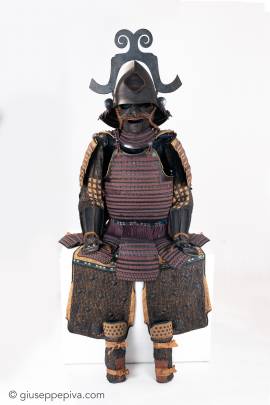Early Edo period (1615–1867) DescriptionThis authentic samurai armor is a tosei gusoku (modern armor), which was common throughout the time period but had certain significant innovations added. The combination of colors and ornamentation is stunning, as is typical of Inaba clan armour, with a rare purple binding (murasaki) used solely by the most senior members of the military aristocracy. The helmet, which is adorned with an amazing and extremely rare kashiradate hooked on the sides, is unquestionably the element that seems to take center stage. This element represents a kotoji,...
WORKS FOR SALE
Edo Period (1615 - 1867), 18th-19th CenturyLength: 25 cm including antennaeSigned: Myōchin Munenaga The iron prawn is constructed of numerous hammered plates, jointed inside the body; the claws open, the body bends and the eyes, antennae, limbs and fins move. The details are finely carved.The earliest known jizai okimono is a dragon bearing the signature of Myōchin Muneaki and dated 1713. The Myōchin were armor makers who excelled in iron forging and hammer work. They are thought to have produced jizai okimono in the peaceful time of the mid-Edo period. In fact, as the demand for armor...
Hineno zunari kabutoHead-shaped samurai helmet PERIODEarly Edo period (1615-1868), 17th centuryPRICE4,000 € This samurai helmet is built with five iron plates that form a flat surface which has been lacquered in black. The neck guard (shikoro) of Hineno type comprises five plates and small fukigaeshi (turned-back portions).Antique samurai helmets of this type were originally made during the late Muromachi period and became popular for their functionality. With such a plain construction they were, in fact, easy to produce but could be made with thick and resistant...
Copyright © 2016 - giuseppe piva - VAT: 05104180962










